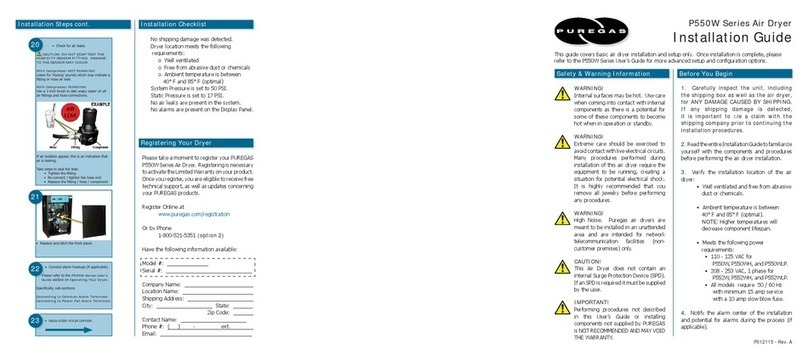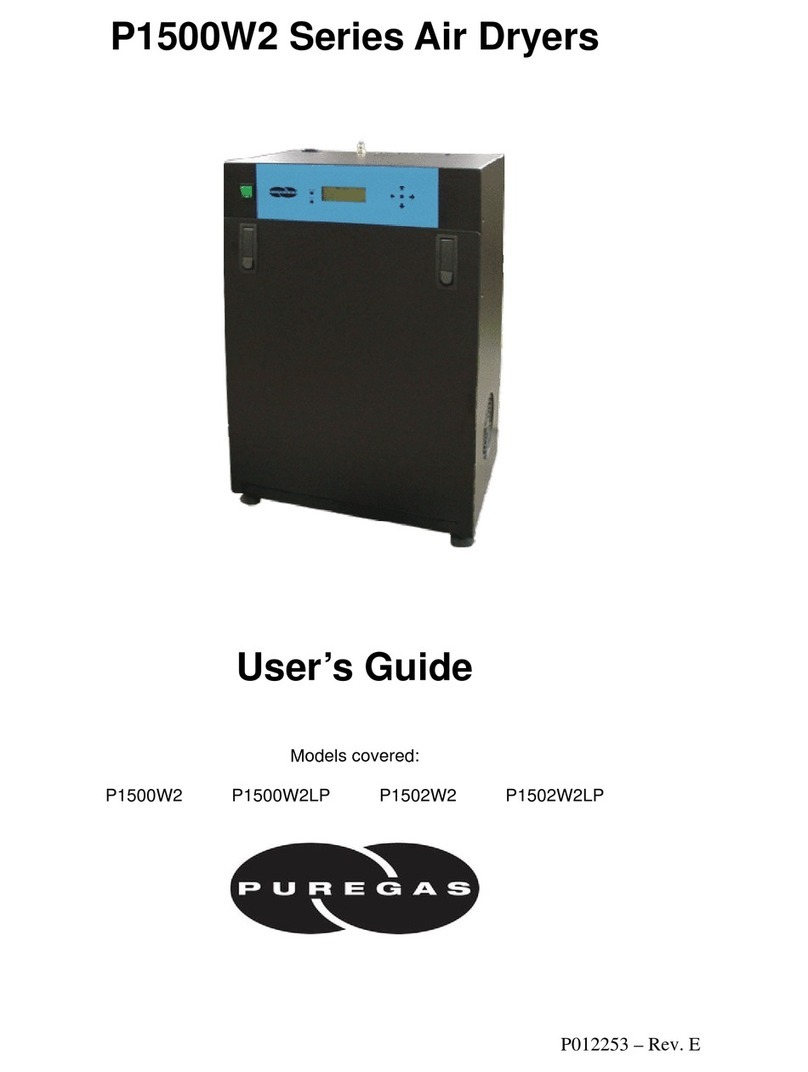
Instruction Manual for PUREGAS
Compressed Air Dryers and Adsorbers
Table of Contents
SECTION 1 – GENERAL...........................................................................................................................................1
SCOPE OF MANUAL ....................................................................................................................................................1
INITIAL INSPECTION ...................................................................................................................................................1
WARRANTY................................................................................................................................................................1
SECTION 2 – DESCRIPTION OF OPERATION...................................................................................................1
GENERAL DESCRIPTION..............................................................................................................................................1
APPLICATIONS............................................................................................................................................................1
OPERATION OF PHF, PCDA, PHCA AND PCME MODELS.........................................................................................2
OPERATION OF PCR MODEL ......................................................................................................................................3
OPERATION OF PMD AND TOC MODELS ...................................................................................................................4
SECTION 3 – INSTALLATION AND OPERATION.............................................................................................5
INSPECTION ................................................................................................................................................................5
LOCATION ..................................................................................................................................................................5
MOUNTING.................................................................................................................................................................5
RECOMMENDED INSTALLATION DIAGRAM.................................................................................................................8
PIPING AND AIR CONNECTIONS ..................................................................................................................................8
INLET AND OUTLET FILTRATION ................................................................................................................................9
PRESSURE AND FLOW CONTROL.................................................................................................................................9
INSTRUMENTATION ..................................................................................................................................................10
ELECTRICAL CONNECTIONS AND TIMER...................................................................................................................10
OPERATING PRESSURE AND SIZING ..........................................................................................................................11
OTHER OPERATING ISSUES.......................................................................................................................................12
SECTION 4 - MAINTENANCE..............................................................................................................................13
GENERAL INFORMATION ..........................................................................................................................................13
ANNUAL INSPECTION ...............................................................................................................................................13
MAINTENANCE SCHEDULE .......................................................................................................................................14
SECTION 5 – REPLACEMENT PARTS...............................................................................................................15
GENERAL INFORMATION ..........................................................................................................................................15
SECTION 6 – TROUBLESHOOTING INFORMATION.....................................................................................21
GENERAL INFORMATION ..........................................................................................................................................21
TROUBLESHOOTING MATRIX....................................................................................................................................21
Figures
FIGURE 1: OPERATION OF PHF, PCDA, PHCA AND PCME MODELS ......................................................................2
FIGURE 2: OPERATION OF PCR MODEL......................................................................................................................3
FIGURE 3: OPERATION OF PMD AND TOC MODELS..................................................................................................4
FIGURE 4: DIMENSIONS OF PHF, PCDA, PHCA, AND PCME MODELS .................................................................5
FIGURE 5: DIMENSIONS OF PCR MODEL ....................................................................................................................6
FIGURE 6: DIMENSIONS OF PMD AND TOC MODELS.................................................................................................7
FIGURE 7: RECOMMENDED INSTALLATION DIAGRAM................................................................................................8
FIGURE 8: WIRING DIAGRAMS...................................................................................................................................11
FIGURE 9: EXPLODED VIEW OF PHF, PCDA, PHCA AND PCME MODELS............................................................15
FIGURE 10: REPLACEMENT PARTS FOR PHF, PCDA, PHCA AND PCME MODELS............................................16
FIGURE 11: EXPLODED VIEW OF PCR MODEL........................................................................................................17
FIGURE 12: REPLACEMENT PARTS FOR PCRMODEL..............................................................................................18
FIGURE 13: EXPLODED VIEW OF PMD AND TOC MODELS .....................................................................................19
FIGURE 14: REPLACEMENT PARTS FOR PMD AND TOC MODELS ..........................................................................20
































